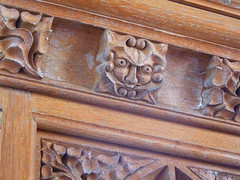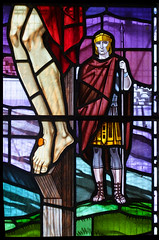| |
|
All
Saints, Fring
 |
|
How
could anyone resist going to Fring, given the
opportunity? The Oxford Dictionary of
Placenames tells us that it is probably
named from being the homestead of a group of
followers of a man called Frea, but the bell-like
tone of that short vowel between the two digraphs
has a charm that mere explanations cannot add to.
And then there is the setting in those rolling
hills and tiny lanes of north-west Norfolk. And
this is a tiny village, and a pretty one with
attractive carstone cottages. The church is above
the street and is proud to be open every day, as
the sign outside assures us. The church appears to have been
built all in one go in the early 14th Century,
and sprawls in its churchyard like a great lazy
lion, Perpendicular Gothic not yet having been
along to wake it up and make it stand to
attention. As Pevsner points out, there was an
1890s restoration, but it only cost £350. That's
about £70,000 in today's money, which sounds a
lot, but you really don't get much for £70,000.
Seeing that the east window was renewed, the roof
was replaced and all the benches are new, that is
probably all they did.
|
All Saints
is a wide, aisleless church, perhaps not typical of this
part of Norfolk. It was full of light on the August day I
visited, and you are immediately struck on entering by
the huge wall painting of St Christopher opposite the
south door - again, common enough in East Anglia, but
unusual around here. In the Middle Ages, prayers were
asked of St Christopher to intercede so that no sudden
death might occur to the petitioner that day, a
particularly urgent request in the years after the Black
Death when the Catholic sacrament of the Last Rites had
achieved a new importance. The image was often painted
opposite the entrance so that locals could stand in the
doorway and make their petition before going about their
daily business. I know old East Anglians who still do
this.
| The
font is slightly earlier than the church, one of
those Purbeck marble fonts so common in this part
of the world, although this one is set on a great
cement drum as if to make it appear part of the
world-famous series of Norman fonts in this part
of Norfolk. There are more wall paintings up in
the south-east corner of the nave, part of a
sequence of figures which may be Saints or even a
Marian sequence. Beside them is an elegant image
niche, intriguingly painted with another figure
at the back. There's a green man on the
pulpit, who looks as if his radar eyes might be
scanning for anyone not listening carefully. Up
in the chancel, a wall memorial features a large
badge of the Royal Flying Corps, precursor to the
RAF. This is most unusual, I don't think I've
ever seen one like it before. It remembers
Richard Edmund Dusgate Dusgate who died for
his county in a German Field Hospital of wounds
received in action, December 19th 1917. This
real life Lord Flashheart was the son of the Lord
of the Manor, and just twenty years old. To the
east, a 1984 window remembers that the Coe family
had been farming at Fring for a hundred years. A
Maille & Son depiction of the collective
mourners at the Crucifixion, it really isn't very
good, and is typical of the loss of nerve of that
decade. But it is unusual, and if I have made it
sound as if Fring church is, in general, a place
which is a little out of the ordinary, then that
would be right I think.
|
|
 |
|
|
|


